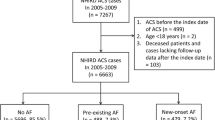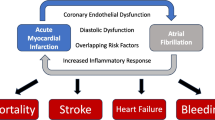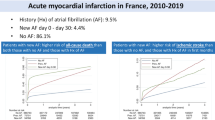Abstract
Background
Atrial fibrillation (AF) in the setting of acute myocardial infarction (AMI) independently predicts in-hospital and long-term morbidity and mortality. Very little data exist regarding the prognostic significance and management of new-onset AF in this setting in the era of dual anti-platelet therapy.
Methods
We identified all patients admitted to our coronary care unit for AMI between 2002 and 2009 who developed new-onset AF. The control group was an age and gender matched group of AMI patients who did not have AF. Management and recurrent AF, non-fatal stroke, and mortality data were collected from subsequent hospitalizations and outpatient records.
Results
Of 1,991 AMI admissions, new-onset AF was diagnosed in 100 (4.1%). Patients’ age was 70 (±12), 32% were female, 58% had ST-elevation AMI and 53% had moderate or worse systolic dysfunction. AF recurred during index admission in 33%. During mean follow-up of 41 months, AF recurred in 22 and 4.5%, and non-fatal stroke occurred in 13 and 1% of the AF and control groups, respectively (p < 0.01 for both). The composite of death and non-fatal stroke was also significantly higher in the AF group, 39 versus 29% (p = 0.02). Oral anti-coagulation was used in only 24% of the AF group and was a significant predictor of stroke-free survival (p = 0.04).
Conclusions
New onset AF in the AMI setting carries a substantial future risk for stroke and should not be regarded as a benign, transient complication of the acute event. Long term anticoagulation is underused and is associated with improved stroke-free survival.



Similar content being viewed by others
References
Lopes RD, Elliott LE, White HD, Hochman JS, Van de Werf F, Ardissino D, Nielsen TT, Weaver WD, Widimsky P, Armstrong W, Granger CB (2009) Antithrombotic therapy and outcomes of patients with atrial fibrillation following primary percutaneous coronary intervention: results from the APEX-AMI trial. Eur Heart J 30:2019–2028
Crenshaw B, Granger C, Stebbins A, Topol E, Califf R (1997) Atrial fibrillation in the setting of acute myocardial infarction: the GUSTO-I experience. Global Utilization of Streptokinase and TPA for Occluded Coronary Arteries. J Am Coll Cardiol 30(2):406–413
Pizzetti F, Turazza FM, Franzosi MG, Barlera S, Ledda A, Maggioni AP, Santoro L, Tognoni G, GISSI-3 Investigators (2001) Incidence and prognostic significance of atrial fibrillation in acute myocardial infarction: the GISSI-3 data. Heart 86(5):527–532
Wong CK, White HD, Wilcox RG, Criger DA, Califf RM, Topol EJ, Ohman EM (2000) New atrial fibrillation after acute myocardial infarction independently predicts death: the GUSTO-III experience. Am Heart J 140(6):878–885
Goldberg RJ, Yarzebski J, Lessard D, Wu J, Gore JM (2002) Recent trends in the incidence rates of and death rates from atrial fibrillation complicating initial acute myocardial infarction: a community-wide perspective. Am Heart J 143(3):519–527
Lehto M, Snapinn S, Dickstein K, Swedberg K, Nieminen MS, OPTIMAAL Investigators (2005) Prognostic risk of atrial fibrillation in acute myocardial infarction complicated by left ventricular dysfunction: the OPTIMAAL experience. Eur Heart J 26(4):350–356
Wong C-K, White HD, Wilcox RG, Criger DA, Califf RM, Topol EJ, Ohman EM (2003) Significance of atrial fibrillation during acute myocardial infarction, and its current management: insights from the GUSTO-3 trial. Card Electrophysiol Rev 7(3):201–207
Jabre P, Roger VL, Murad MH, Chamberlain AM (2011) Mortality Associated With Atrial Fibrillation in Patients With Myocardial Infarction: A Systematic Review and Meta-Analysis. Circulation 123:1587–1593
Siu C-W, Jim M-H, Ho H–H, Miu R, Lee SWL, Lau C-P, Tse H-F (2007) Transient atrial fibrillation complicating acute inferior myocardial infarction: implications for future risk of ischemic stroke. Chest 132(1):44–49
Camm AJ, Kirchhof P, Lip GYH, Schotten U, Savelieva I, Ernst S, Gelder ICV, Al-Attar N, Hindricks G, Prendergast B, Heidbuchel H, Alfieri O, Angelini A, Atar D, Colonna P, Caterina RD, Sutter JD, Goette A, Gorenek B, Heldal M, Hohloser SH, Kolh P, Heuzey J-YL, Ponikowski P, Rutten FH (2010) Guidelines for the management of atrial fibrillation: the Task Force for the Management of Atrial Fibrillation of the European Society of Cardiology (ESC). Eur Heart J 31(19):2369–2429
Stenestrand U, Lindback J, Wallentin L, RIKS-HIA Registry (2005) Anticoagulation therapy in atrial fibrillation in combination with acute myocardial infarction influences long-term outcome: a prospective cohort study from the Register of Information and Knowledge About Swedish Heart Intensive Care Admissions (RIKS-HIA). Circulation 112(21):3225–3231
Pedersen OD, Bagger H, Kober L, Torp-Pedersen C (1999) Trandolapril reduces the incidence of atrial fibrillation after acute myocardial infarction in patients with left ventricular dysfunction. Circulation 100(4):376–380
Køber L, Thomsen PEB, Møller M, Torp-Pedersen C, Carlsen J, Sandøe E, Egstrup K, Agner E, Videbaek J, Marchant B, Camm AJ (2000) Effect of dofetilide in patients with recent myocardial infarction and left-ventricular dysfunction: a randomised trial. Lancet 356(9247):2052–2058
Becker T, Kleemann T, Strauss M, Doenges K, Schneider S, Senges J, Seidl K (2008) Long-term prognosis after cardioversion of the first episode of symptomatic atrial fibrillation: a condition believed to be benign revised. Clin Res Cardiol 97(2):74–82
Connolly S, Pogue J, Hart R, Pfeffer M, Hohnloser S, Chrolavicius S, Yusuf S (2006) Clopidogrel plus aspirin versus oral anticoagulation for atrial fibrillation in the Atrial fibrillation Clopidogrel Trial with Irbesartan for prevention of Vascular Events (ACTIVE W): a randomised controlled trial. Lancet 367(9526):1903–1912
Eldar M, Canetti M, Rotstein Z, Boyko V, Gottlieb S, Kaplinsky E, Behar S, SPRINT and Thrombolytic Survey Groups (1998) Significance of paroxysmal atrial fibrillation complicating acute myocardial infarction in the thrombolytic era. Circulation 97(10):965–970
Kirchhof P, Auricchio A, Bax J, Crijns H, Camm J, Diener HC, Goette A, Hindricks G, Hohnloser S, Kappenberger L (2007) Outcome parameters for trials in atrial fibrillation: executive summary. Eur Heart J 28(22):2803
Lopes RD, Starr A, Pieper CF, Al-Khatib SM, Newby LK, Mehta RH, de Werf FV, Mahaffey KW, Armstrong PW, Harrington RA, White HD, Wallentin L, Granger CB (2010) Warfarin use and outcomes in patients with atrial fibrillation complicating acute coronary syndromes. Am J Med 123(2):134–140
Conflict of interest
The authors declare that they have no conflict of interest.
Author information
Authors and Affiliations
Corresponding author
Rights and permissions
About this article
Cite this article
Zusman, O., Amit, G., Gilutz, H. et al. The significance of new onset atrial fibrillation complicating acute myocardial infarction. Clin Res Cardiol 101, 17–22 (2012). https://doi.org/10.1007/s00392-011-0357-5
Received:
Accepted:
Published:
Issue Date:
DOI: https://doi.org/10.1007/s00392-011-0357-5




